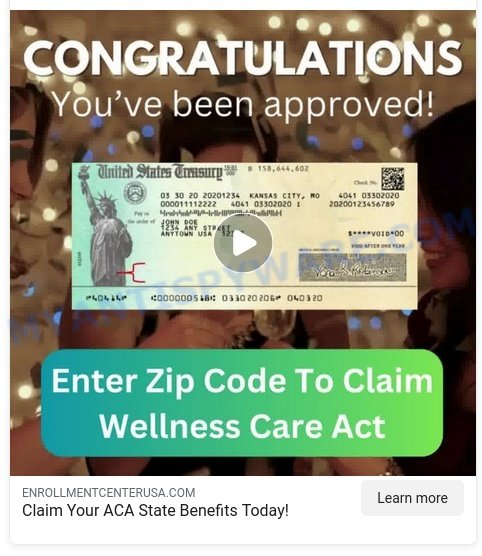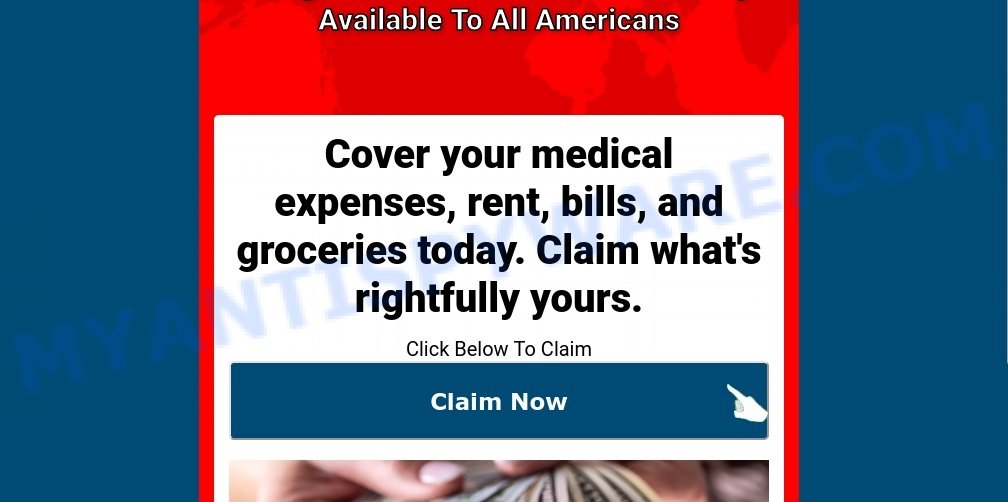Have you come across YouTube or Facebook ads promising a $6400 stimulus check or free subsidy from the government? Beware, as these offers are nothing but a sophisticated scam. Despite their convincing appearance, often featuring deep fakes of celebrities or public figures like Dr. Phil, Joe Rogan, or even Joe Biden, these ads are designed to deceive. Read on to learn more about the $6400 Stimulus Scam, how to spot it, and what actions to take if you encounter it.

Table of Contents
🚨 What is the $6400 Stimulus Scam
The $6400 Stimulus Scam is a sophisticated fraud currently spreading across YouTube, TikTok, Facebook, and other social media platforms. It prominently features AI-generated deep fake videos of well-known figures like Dr. Phil, Joe Rogan, Andrew Tate, Steve Harvey, and even President Joe Biden. These counterfeit videos falsely suggest these public figures endorse a $6400 stimulus check from the government.

Victims who click on these ads are redirected to fake government websites designed to harvest personal information, such as names, birth dates, and contact details. The pretense is to verify eligibility for the stimulus money.
The danger intensifies when scammers, armed with the victim’s information, impersonate government agents and pressure them into paying made-up fees or taxes. These payments are often demanded in untraceable forms like gift cards or cryptocurrency transfers.
Overall, the $6400 Stimulus Scam is a calculated ploy that preys on individuals during economically challenging times, enticing them with a false promise of government money in exchange for sensitive personal data and money.
🚩 Signs of the $6400 Stimulus Scam
Recognizing the $6400 Stimulus Scam is crucial to avoid falling victim to it. Here are some signs to watch out for:
- 🔍 Unverified Claims: Advertisements that claim the government is offering a $6400 stimulus check, which is not corroborated by official government websites.
- 🎭 Use of Deep Fakes: The scam ads often feature deep fake videos of celebrities or public figures endorsing the stimulus, which can be surprisingly convincing.
- 📢 Promotion on Social Media: These scams are mainly advertised on platforms like YouTube, using the platform’s vast reach to target a wide audience.
- 💸 Too Good to Be True: The offers may seem incredibly generous or too good to be true, a common trait of many scams.
🕵️♂️ How the $6400 Stimulus Scam Works
The $6400 Stimulus Check Scam is a complex scheme targeting users on social media, through fake websites and phone calls. Let’s break down each phase of this scam:
1️⃣ Fake Celebrity Endorsement Ads
The scam starts with deceptive ads featuring deep fake videos of celebrities like Dr. Phil, Joe Rogan, Andrew Tate, Steve Harvey, and Joe Biden. These AI-generated videos are alarmingly realistic.
📺 The ads claim the government is offering a $6400 subsidy stimulus check, urging quick action due to limited funds. Since these videos use familiar faces, people are misled into believing the offer is real, unaware that the endorsements are entirely fake.
2️⃣ Phishing Website
Clicking the ad leads to a 🌐 phishing website designed to mimic a government agency. Here, you’re congratulated for qualifying for the $6400 stimulus and asked to enter personal details like your name, birthdate, social security number, and banking info.
🔐 A false disclaimer assures confidentiality, but in reality, this is a trap to steal your identity and funds.
3️⃣ Follow-Up Call from a Fake Government Agent
Within a day of submitting your details, a “government agent” (actually a scammer) calls you. They confirm your eligibility and ask for an “activation fee” to release the stimulus funds into your account.
💰 This demand for an upfront fee is a lie designed to con you out of your money. Real government checks don’t require such fees, but the scammer will pressure you to pay.
4️⃣ Untraceable Payment Demands
On the call, the scammer demands payment for the fee using untraceable methods like gift cards or cryptocurrency. They might even try to access your computer or bank account directly, which is something no legitimate government agent would do.
🔄 In some cases, they fake a bank deposit error and ask you to wire back the $6400, tricking you into sending money directly to them.
5️⃣ Disappearance Act
After receiving your payment or banking information, the scammers vanish. Attempts to contact them fail as websites and phone numbers used in the scam disappear.
💔 Victims are left with no way to recover stolen gift cards or cryptocurrency, and the promised $6400 stimulus never materializes.
In conclusion, awareness and caution are key. If you encounter such offers, remember that genuine government programs don’t operate this way. Avoid these scams to protect your identity and finances.
😱 What to Do if You Encounter the $6400 Stimulus Scam
If you come across what seems like the $6400 Stimulus Scam, here’s how you can respond:
- Do Not Click: Avoid clicking on the ad or providing any personal information.
- Report the Ad: Report the scam to YouTube and any other platform where you see the ad.
- Verify Information: Always verify such claims through official government websites like benefits.gov, govloans.gov, and grants.gov.
- Educate Others: Warn your friends and family about the scam to prevent them from falling victim.
Summary Table for the $6400 Stimulus Scam
| Name | $6400 Stimulus Scam, $6400 Subsidy Scam |
|---|---|
| Type | Financial Scam |
| Damage | Financial loss, identity theft |
| Distribution | YouTube, Facebook, Social Media |
| Tactics | Deep fake endorsements, fraudulent websites |
| Prevention Tips | Verify through official sources, be skeptical of too-good-to-be-true offers, educate others |
| Reporting Info | Report to YouTube, FTC, local authorities |
How to Spot This Scam on Social Media
Scammers are exploiting social media platforms like Facebook, YouTube, and TikTok to promote a fake $6400 stimulus check. Here’s how to identify these scams on each platform:
- 🚨 Clickbait Advertisements: Look out for ads with phrases like “Claim your $6400 payment now!” often using images of celebrities like Dr. Phil or Joe Rogan.
- 🔍 Deceptive Government Pages: Be wary of pages with names slightly off from real ones, such as “U.S. Stimulis Agency”, filled with scam posts.
- 💬 Fabricated Comments: Scam posts are usually flooded with comments like “Thanks, I got mine!” from bot accounts to fake legitimacy.
- 🔗 Suspicious Links: Avoid engaging with shortened links in these posts, often leading to phishing sites.
- 🕵️♂️ Profile Red Flags: Profiles posting these ads might show signs like stock images, recent creation, or international locations.
YouTube
- 📹 AI-Generated Celebrity Videos: Ads might feature deep fake videos of figures like Steve Harvey, appearing to endorse the stimulus offer.
- 🚫 Missing Ad Disclosures: Legitimate ads are labeled as promotions; scam ads often skip this, hinting at their fraudulent nature.
- 🌐 Phishing Hyperlinks: Watch out for links like “clstimulusbenefit.com” in video descriptions that don’t lead to real government sites.
- 💬 Manipulated Comments: Suspicious uniformly positive comments from bot accounts or disabled comment sections are common in scam ads.
- 👤 Channel Anomalies: Scam channels often have generic stock images, lack real content uploads, and show recent join dates.
TikTok
- 🤖 Deep Fake Alerts: Short videos with unrealistic offers from AI impersonations of celebrities should raise suspicion.
- 👏 Bogus Positive Feedback: Like other platforms, fake TikTok accounts often praise the scam in comments to seem authentic.
- #️⃣ Misleading Hashtags: Scam posts might use hashtags like #6400stimulus for greater exposure.
- ✉️ Dubious Info Requests: Avoid replying to prompts asking to comment “info”, which lead to questionable contacts and websites.
- 🕵️♀️ Profile Clues: Examine profiles for stock imagery, foreign locations, or suspicious bio links.
- 📸 Stolen Influencer Images: Scammers might use photos of well-known influencers, falsely suggesting their endorsement.
- 🌐 Fake URLs in Bio: Profiles promoting the scam often include misleading URLs in their bio, directing to fraudulent websites.
General Tip:
Always rely on official government accounts for accurate stimulus information. Report any suspicious activities to help protect others from falling prey to these scams.
Conclusion
The $6400 Stimulus Scam is a sophisticated attempt to exploit unsuspecting individuals by offering a non-existent government subsidy. By being vigilant, verifying information through reliable sources, and spreading awareness, you can protect yourself and others from falling prey to such fraudulent schemes. Remember, if an offer seems too good to be true, it probably is.
















